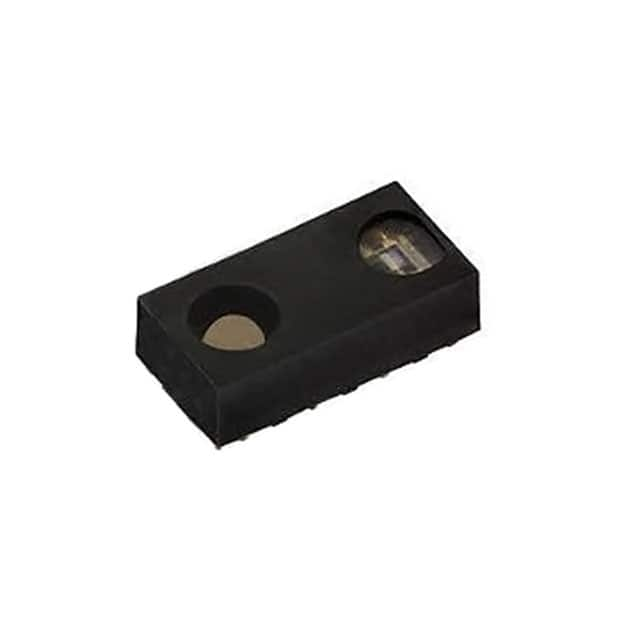Viz Specifikace pro podrobnosti o produktu.

VCNL4040M3OE-H5
Introduction
The VCNL4040M3OE-H5 is a proximity and ambient light sensor designed for various applications. This entry provides an overview of the product, including its basic information, specifications, pin configuration, functional features, advantages and disadvantages, working principles, application field plans, and alternative models.
Basic Information Overview
- Category: Proximity and Ambient Light Sensor
- Use: The VCNL4040M3OE-H5 is used to detect proximity and measure ambient light in electronic devices.
- Characteristics: It offers high sensitivity, low power consumption, and a compact package.
- Package: The sensor is available in a small surface-mount package.
- Essence: The essence of the VCNL4040M3OE-H5 lies in its ability to provide accurate proximity and ambient light measurements.
- Packaging/Quantity: The sensor is typically packaged in reels or trays containing a specific quantity per package.
Specifications
- Proximity Sensing Range: Up to 20 cm
- Ambient Light Sensing Range: 0.25 lux to 16k lux
- Operating Voltage: 1.7V to 3.6V
- Current Consumption: 240 µA (typical)
- I2C Interface: Up to 400 kHz
- Package Type: Surface Mount
- Dimensions: 4.9mm x 2.4mm x 0.85mm
Detailed Pin Configuration
The VCNL4040M3OE-H5 has a standard pin configuration with specific pins dedicated to power supply, I2C communication, and proximity/ambient light sensing.
| Pin Name | Function | |----------------|-------------------| | VDD | Power Supply | | GND | Ground | | SDA | I2C Data Line | | SCL | I2C Clock Line | | INT | Interrupt Output | | PS | Proximity Sense | | ALS | Ambient Light Sense|
Functional Features
- Proximity Sensing: The sensor uses an integrated IR emitter and photodiode to accurately measure proximity.
- Ambient Light Sensing: It utilizes a photodiode with advanced digital ambient light suppression to provide precise ambient light measurements.
- Integrated Signal Conditioning: The VCNL4040M3OE-H5 includes signal conditioning circuitry to enhance measurement accuracy.
- Interrupt Function: It offers an interrupt feature to alert the host controller when certain conditions are met.
Advantages and Disadvantages
Advantages
- High sensitivity for both proximity and ambient light sensing.
- Low power consumption, making it suitable for battery-powered devices.
- Small form factor for easy integration into compact designs.
Disadvantages
- Limited proximity sensing range compared to some other sensors in the market.
- Requires careful calibration for optimal performance in varying ambient light conditions.
Working Principles
The VCNL4040M3OE-H5 operates based on the principles of infrared reflection for proximity sensing and photodiode-based light detection for ambient light measurements. When the IR emitter emits light, the reflected light is detected by the photodiode, allowing the sensor to determine proximity. For ambient light sensing, the photodiode measures the intensity of incoming light, which is then converted into a digital value for further processing.
Detailed Application Field Plans
The VCNL4040M3OE-H5 is well-suited for a wide range of applications, including: - Mobile Devices: Proximity detection for touchscreen control and automatic display brightness adjustment. - Wearable Electronics: Ambient light sensing for automatic adjustment of screen brightness. - Industrial Automation: Proximity sensing for object detection and ambient light measurement for environmental monitoring. - Consumer Electronics: Proximity detection for gesture recognition and ambient light sensing for backlight control.
Detailed and Complete Alternative Models
Some alternative models to the VCNL4040M3OE-H5 include: - VCNL4040X01: A variant with extended proximity sensing range. - VCNL4040M3OE-H6: A higher precision version with improved ambient light sensing capabilities. - VCNL4040M3OE-H7: A lower power consumption variant optimized for battery-operated devices.
In conclusion, the VCNL4040M3OE-H5 is a versatile proximity and ambient light sensor with a compact design and high sensitivity, making it suitable for various electronic applications.
Word Count: 611
Seznam 10 běžných otázek a odpovědí souvisejících s aplikací VCNL4040M3OE-H5 v technických řešeních
What is the VCNL4040M3OE-H5 sensor used for?
- The VCNL4040M3OE-H5 sensor is commonly used for proximity sensing, ambient light sensing, and gesture recognition in various technical solutions.
How does the VCNL4040M3OE-H5 sensor work?
- The VCNL4040M3OE-H5 sensor uses a combination of infrared emitter, photodiode, and signal processing to detect proximity, measure ambient light levels, and recognize gestures.
What are the typical applications of the VCNL4040M3OE-H5 sensor?
- Typical applications of the VCNL4040M3OE-H5 sensor include touchless switches, display dimming control, gesture-controlled devices, and proximity detection in consumer electronics and industrial automation.
What is the operating voltage range of the VCNL4040M3OE-H5 sensor?
- The VCNL4040M3OE-H5 sensor typically operates within a voltage range of 2.5V to 3.6V.
Can the VCNL4040M3OE-H5 sensor be used outdoors?
- The VCNL4040M3OE-H5 sensor can be used outdoors with proper protection from environmental factors such as moisture and direct sunlight.
What is the maximum range of proximity detection for the VCNL4040M3OE-H5 sensor?
- The VCNL4040M3OE-H5 sensor has a maximum proximity detection range of up to 300mm, depending on the specific implementation and environmental conditions.
Does the VCNL4040M3OE-H5 sensor support I2C communication?
- Yes, the VCNL4040M3OE-H5 sensor supports I2C communication for interfacing with microcontrollers and other digital systems.
Is the VCNL4040M3OE-H5 sensor suitable for battery-powered devices?
- Yes, the VCNL4040M3OE-H5 sensor is designed to operate efficiently in low-power modes, making it suitable for battery-powered devices.
Can the VCNL4040M3OE-H5 sensor differentiate between different types of gestures?
- Yes, the VCNL4040M3OE-H5 sensor is capable of recognizing various predefined gestures, such as swipes, taps, and rotations, through its integrated gesture recognition algorithm.
Are there any specific considerations for integrating the VCNL4040M3OE-H5 sensor into a technical solution?
- When integrating the VCNL4040M3OE-H5 sensor, it's important to consider factors such as ambient light interference, optical crosstalk, and proper calibration for accurate proximity and gesture detection.

